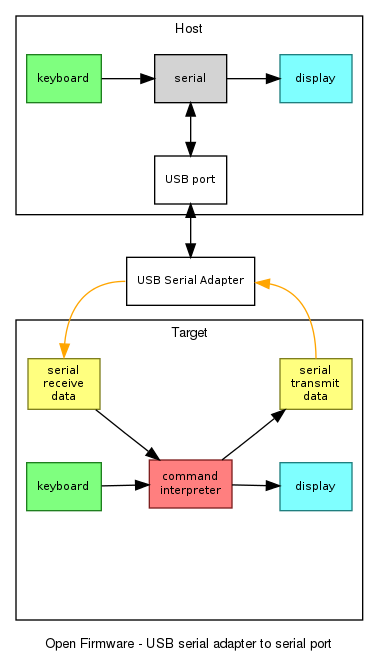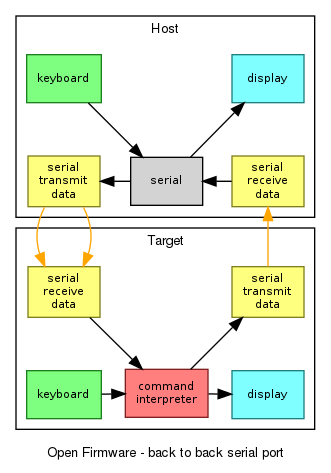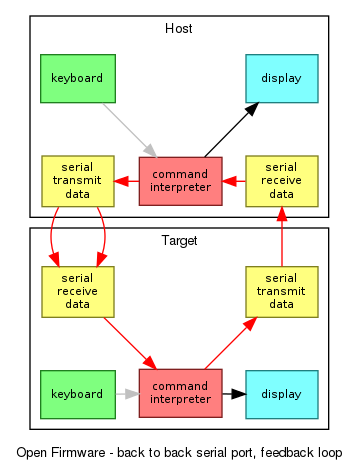Firmware/Serial Terminal: Difference between revisions
(Created page with '= Firmware Serial Terminal = Open Firmware contains a serial terminal emulator that can be used for diagnosis of the laptop, and other laptops. {| border="1" cellspacing="0" ce…') |
No edit summary |
||
| Line 17: | Line 17: | ||
|- |
|- |
||
|} |
|} |
||
= Using a USB serial adapter = |
|||
How to use an XO as a serial terminal to another XO, using a USB serial adapter. |
|||
You will require: |
|||
* an XO to act as host, with a build of Open Firmware after svn 3568, |
|||
* a USB serial adapter, |
|||
* a USB cable, type A male to type B female, |
|||
* an XO to act as target. |
|||
Preparation: |
|||
* connect the target XO to the USB serial adapter, |
|||
* connect the B end of the USB cable to the serial adapter, |
|||
* connect the A end of the USB cable to the host XO. |
|||
Starting: |
|||
* start the program: |
|||
ok serial |
|||
The program supports some key sequences used by screen: |
|||
* ctrl+a k or ctrl+a ctrl+d to exit, |
|||
* ctrl+a ctrl+b to send a break, |
|||
* ctrl+a ctrl+a to send a ctrl+a, |
|||
* ctrl+a C to clear the screen. |
|||
= Logging = |
|||
How to record a log of the session: |
|||
ok serial-log u:\file.log |
|||
= Remote = |
|||
How to use an XO as a network serial adapter for another XO, using a USB serial adapter. |
|||
* follow the preparation steps above, |
|||
* configure Open Firmware networking, |
|||
* start a telnet server: |
|||
ok telnetd |
|||
* note the IP address displayed, |
|||
* connect with telnet to the server, and start the serial program, |
|||
% telnet 10.0.0.1 |
|||
ok serial |
|||
= Using back to back serial ports = |
|||
How to use an XO as a serial terminal (host) to another XO (target), without using any USB serial adapters: |
|||
* on the XO acting as host, get to the [[Ok]] prompt, and set up to use the serial port: |
|||
ok use-uart |
|||
* start the program: |
|||
ok serial |
|||
* connect a crossover cable, |
|||
* turn on the target. |
|||
Caution: the <code>use-uart</code> command turns off the Open Firmware serial console, to avoid unpleasant interaction between the Open Firmware ok prompt and any connected device. Connecting the cable before <code>use-uart</code> may result in each laptop screaming at the other repeatedly. |
|||
A crossover cable, to join two OLPC-supplied serial cables, consists of the following: |
|||
{| border="1" cellspacing="0" cellpadding="2" width="100%" class="wikitable" |
|||
! host pin (cable colour) |
|||
! target pin (cable colour) |
|||
! purpose |
|||
|- |
|||
| GND (orange) |
|||
| GND (orange) |
|||
| ground |
|||
|- |
|||
| RX (red) |
|||
| TX (green) |
|||
| display data, target to host |
|||
|- |
|||
| TX (green) |
|||
| RX (red) |
|||
| keyboard data, host to target |
|||
|- |
|||
|} |
|||
The 3.3V (black) pin is not connected. |
|||
A crossover cable may also be fabricated from two PCB connectors, or using wire soldered to the connector pads. |
|||
= How it works - with a USB serial adapter = |
= How it works - with a USB serial adapter = |
||
| Line 38: | Line 121: | ||
[[Image:Ofw-ser2ser-bad.png|0px]] |
[[Image:Ofw-ser2ser-bad.png|0px]] |
||
= References = |
|||
* [http://tracker.coreboot.org/trac/openfirmware/browser/cpu/x86/pc/olpc/terminal.fth terminal.fth] |
|||
* [http://lists.laptop.org/pipermail/devel/2012-March/034678.html mailing list post], |
|||
* [http://dev.laptop.org/git/users/quozl/olpc-firmware-terminal.git/ git repository via web], (before it was merged), |
|||
* git://dev.laptop.org/users/quozl/olpc-firmware-terminal.git git repository (before it was merged), |
|||
Revision as of 05:07, 26 February 2013
Firmware Serial Terminal
Open Firmware contains a serial terminal emulator that can be used for diagnosis of the laptop, and other laptops.
| command | purpose |
|---|---|
serial
|
connect the keyboard and display to the serial port |
use-usb
|
set up serial to use a USB serial adapter, the default.
|
use-uart
|
set up serial to use the built-in serial port UART.
|
Using a USB serial adapter
How to use an XO as a serial terminal to another XO, using a USB serial adapter.
You will require:
- an XO to act as host, with a build of Open Firmware after svn 3568,
- a USB serial adapter,
- a USB cable, type A male to type B female,
- an XO to act as target.
Preparation:
- connect the target XO to the USB serial adapter,
- connect the B end of the USB cable to the serial adapter,
- connect the A end of the USB cable to the host XO.
Starting:
- start the program:
ok serial
The program supports some key sequences used by screen:
- ctrl+a k or ctrl+a ctrl+d to exit,
- ctrl+a ctrl+b to send a break,
- ctrl+a ctrl+a to send a ctrl+a,
- ctrl+a C to clear the screen.
Logging
How to record a log of the session:
ok serial-log u:\file.log
Remote
How to use an XO as a network serial adapter for another XO, using a USB serial adapter.
- follow the preparation steps above,
- configure Open Firmware networking,
- start a telnet server:
ok telnetd
- note the IP address displayed,
- connect with telnet to the server, and start the serial program,
% telnet 10.0.0.1 ok serial
Using back to back serial ports
How to use an XO as a serial terminal (host) to another XO (target), without using any USB serial adapters:
- on the XO acting as host, get to the Ok prompt, and set up to use the serial port:
ok use-uart
- start the program:
ok serial
- connect a crossover cable,
- turn on the target.
Caution: the use-uart command turns off the Open Firmware serial console, to avoid unpleasant interaction between the Open Firmware ok prompt and any connected device. Connecting the cable before use-uart may result in each laptop screaming at the other repeatedly.
A crossover cable, to join two OLPC-supplied serial cables, consists of the following:
| host pin (cable colour) | target pin (cable colour) | purpose |
|---|---|---|
| GND (orange) | GND (orange) | ground |
| RX (red) | TX (green) | display data, target to host |
| TX (green) | RX (red) | keyboard data, host to target |
The 3.3V (black) pin is not connected.
A crossover cable may also be fabricated from two PCB connectors, or using wire soldered to the connector pads.
How it works - with a USB serial adapter
When a USB serial adapter is plugged in, and the serial program started, then keyboard input is passed by the program to the USB serial adapter, and thence to the target. Data from the target is received and displayed.
How it works - serial ports connected back to back
This diagram shows when serial ports are connected back to back, with the serial program already started. Keyboard input on either the host or the target eventually reaches the target command interpreter.
How to fail - doing things in the wrong order
This final diagram shows a pathological data loop. The serial program has not been started, so the Ok prompt from one host is sent as if it is keyboard input into the other host, which sends it back to the first host, and so on.
To avoid this:
- use a USB serial adapter, or
- keep the target power off until the
serialprogram has been started.
References
- terminal.fth
- mailing list post,
- git repository via web, (before it was merged),
- git://dev.laptop.org/users/quozl/olpc-firmware-terminal.git git repository (before it was merged),


